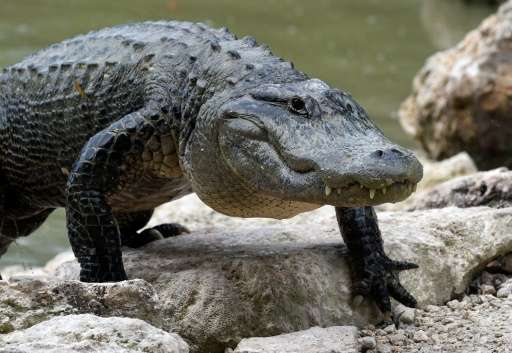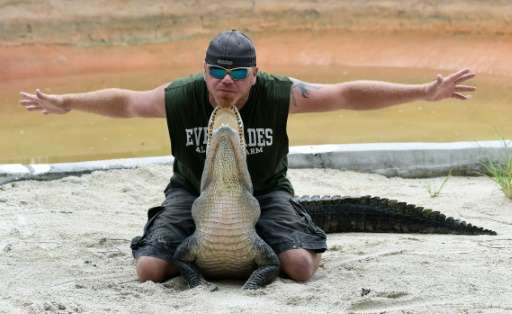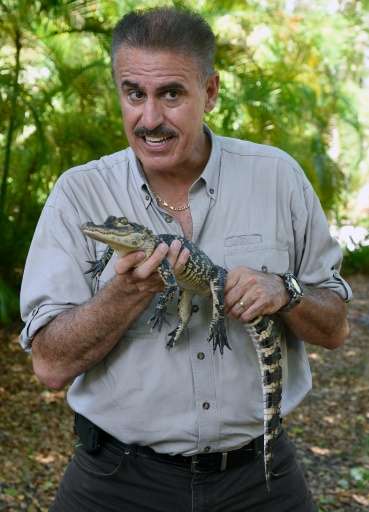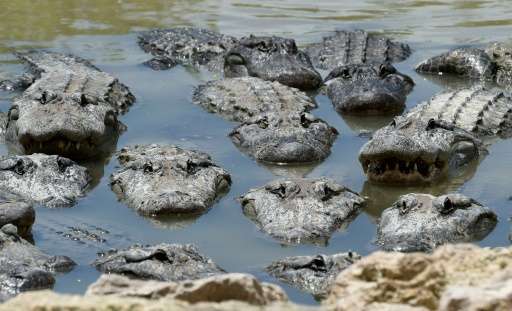Encounters between gators, humans on the rise in Florida

At a small outdoor amphitheater in the Florida swamp, about 50 tourists gawk at the spectacle center stage: a man placing his head between the massive jaws of an alligator.
Later, patrons at the Everglades Alligator Farm—one of many Florida establishments featuring gator shows—get a chance to cradle a baby gator, which is passed excitedly between sweaty hands, amid a barrage of selfies.
"My husband is a big fan of reptiles, so while we were in Florida, we simply had to make a stop at a wildlife reserve," said Emilia Armendariz, 34, a visitor from Ecuador.
Florida, famed for its sandy beaches, is almost as well known for its alligators, an iconic symbol of the swamp-filled southeastern US state that is the natural habitat for the fearsome reptiles.
Humans are not their favorite meal, but you wouldn't know that from the recent series of alarming gator attacks on people.
The most recent incident—the death of a two-year-old boy in an attack last month at a Disney World resort in Orlando—made headlines around the world.
The reptile snatched the child as he frolicked at the edge of a man-made lake, and his father was unable to free him from the animal's grip.
The toddler's body was recovered the next day.
Just days before, an gator was seen in the city of Lakeland in central Florida with a human body clenched between its teeth. A similar incident was reported about 200 miles (320 kilometers) away in Fort Lauderdale.

The incidents have been multiplying with alarming rapidity.
In another case last month, one of the giant reptiles reportedly bit a man's leg. In May, an alligator ripped the arm off a fugitive trying to escape the police.
Vying for territory
Ron Magill, spokesman for the Miami Zoo and animal behavior expert, says that humans and gators increasingly find themselves vying for the same territory.
"I think we're probably having more incidents between alligators and humans because there are more alligators, there are more humans, and humans are now building into alligator habitat," Magill told AFP.
By the 1970s, the alligator population in Florida had dwindled to just several thousand, and the reptiles were classified as an endangered species, Magill told AFP.
Today, thanks to conservation efforts, they number some 1.3 million.
At the same time, the human population has also increased, rising 7.8 percent between 2010 and 2015, according to the US Census Bureau, from 18.8 million to 20.3 million.
The human population growth has forced the reptiles to be more resourceful as their habitat is encroached upon.

"Alligators are learning to adapt. They are going to go into residential areas if there are lakes, man-made lakes, canals," Magill said.
"Alligators use the canals, lakes and bodies of water throughout Florida almost like a freeway system. They use that to go from one area to another."
Golf gator
The US Fish and Wildlife Service has warned residents of the increasing likelihood of close encounters with gators.
"Florida has experienced tremendous human population growth. Many residents seek waterfront homes, and increasingly participate in water-related activities," the FWS said in a statement.
"This can result in more frequent alligator-human interactions, and a greater potential for conflict."
Not all of these conflicts end in tragedy.
A gator recently became an Internet sensation when it took a casual stroll through a Florida golf course.
And it is quite a common phenomenon to hear about gators lounging in a family swimming pool.

"Just because you think that you have a fence around it, or that it's isolated on the golf course, or it's a man-made lake, that you aren't going to find alligators, that would be a big mistake," Magill said.
"Alligators travel quite a bit over land to go from one body of water to another body of water, especially after the breeding season, or during the breeding season, when the males are looking for females," he said.
The most dangerous periods are between April and June, when gators are looking to mate, and from June to August, when they are tending their nests and awaiting the emergence of their hatchlings.
A relatively safe place for gator encounters are the nature preserves like the Everglades Alligator Farm, which despite some of the performance aspects of its shows, promotes itself as an educational venture.
Jeremy Possman, manager of the Everglades Alligator Farm, told AFP that the staff hammers home the message that gators are dangerous animals.
They advise patrons to avoid fresh waters in Florida to limit the chance of a close encounter of the reptile kind.
"An alligator has a natural fear of men, and one of the first things that they always teach you is don't feed alligators," Possman said.
"What they need is to be respected for what they are, left alone, and if you have an alligator in your backyard, don't feed them."
© 2016 AFP


















